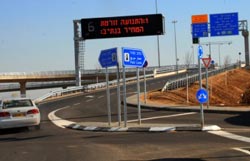Dynamic Toll for Smooth-Flowing Traffic

In return, the system lets motorists enjoy the benefits of getting to their destinations more quickly, while also helping to prevent traffic jams and reduce fuel consumption and CO2 emissions. The first special highway lane with the innovative control system, known as the “fast lane”, is on the highway connecting Jerusalem and Tel Aviv in Israel.
Many densely populated areas have problems with traffic during peak periods. Special lanes whose use is subject to a fee are often provided to improve the flow of traffic and encourage people to form car pools or use public transportation. The greatest challenge here is the need to set the fees at a level that will ensure the lane’s capacity is sufficiently utilized and that traffic jams will be prevented. Siemens Mobility has responded to this challenge by developing a traffic control system that enables a steady driving speed while ensuring optimal use of capacity.
The system uses induction loops in the road surface to register the speed and numbers of vehicles on the free driving lanes and the fast lane. The heart of the system is a complex algorithm that uses the measured data to calculate the toll fees down to the minute. Ultimately this leads to evenly distributed traffic density on the special lane: When traffic is light, the toll fee drops, giving drivers an incentive to use the lane. When traffic gets heavier, the fee increases, which deters some drivers and thus prevents congestion. The updated toll fee is displayed on electronic traffic signs at entrances to the fast lane. For calculating the toll fee, a video system films the vehicle’s license plate number when it enters the lane. The fee can be debited from the bank accounts of drivers who have registered for this option in advance; otherwise they receive a bill. Buses and fully occupied vehicles are exempt from the toll. The fast lane is 12 kilometers long and makes it possible to cover the distance in about 12 minutes — compared to the 30 to 60 minutes the trip can take during peak hours.
The fast lane was built by Shapir Civil & Marine Engineering Ltd., an Israeli company. And another Israeli company, R.S. Industries / Orad Group, is responsible for toll billing. From Siemens’ point of view, a very promising market for the new traffic control system is the U.S., where there are already many fast lanes in use, but so far with little flexibility of toll calculation.
Media Contact
More Information:
http://www.siemens.com/innovationnewsAll latest news from the category: Transportation and Logistics
This field deals with all spatial and time-related activities involved in bridging the gap between goods and people, including their restructuring. This begins with the supplier and follows each stage of the operational value chain to product delivery and concludes with product disposal and recycling.
innovations-report provides informative reports and articles on such topics as traffic telematics, toll collection, traffic management systems, route planning, high-speed rail (Transrapid), traffic infrastructures, air safety, transport technologies, transport logistics, production logistics and mobility.
Newest articles

You are What You Eat—Stanford Study Links Fiber to Anti-Cancer Gene Modulation
The Fiber Gap: A Growing Concern in American Diets Fiber is well known to be an important part of a healthy diet, yet less than 10% of Americans eat the minimum recommended…

Trust Your Gut—RNA-Protein Discovery for Better Immunity
HIRI researchers uncover control mechanisms of polysaccharide utilization in Bacteroides thetaiotaomicron. Researchers at the Helmholtz Institute for RNA-based Infection Research (HIRI) and the Julius-Maximilians-Universität (JMU) in Würzburg have identified a…

ASXL1 Mutation: The Hidden Trigger Behind Blood Cancers and Inflammation
Scientists show how a mutated gene harms red and white blood cells. LA JOLLA, CA—Scientists at La Jolla Institute for Immunology (LJI) have discovered how a mutated gene kicks off…



